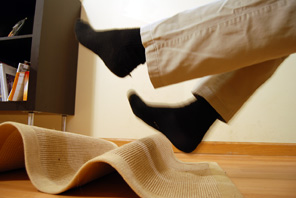Latest News
Patient Portal Brochures Available Now!
Joe Caristi joins Speare Memorial Hospital as Chief Financial Officer
By Michelle McEwen, FACHE, President & CEO
 It’s not an unfamiliar story . . . an elderly family member or friend has fallen and sustained a life-changing injury. In fact one in three adults over the age of 65 falls each year, according to the Centers for Disease Control (CDC). Further, 20 to 30 percent of them will suffer moderate to severe injuries that can impact their mobility and/or ability to continue living independently. Based on 2013 data, the CDC reports the cost of falls in older adults to be $34 billion annually.
It’s not an unfamiliar story . . . an elderly family member or friend has fallen and sustained a life-changing injury. In fact one in three adults over the age of 65 falls each year, according to the Centers for Disease Control (CDC). Further, 20 to 30 percent of them will suffer moderate to severe injuries that can impact their mobility and/or ability to continue living independently. Based on 2013 data, the CDC reports the cost of falls in older adults to be $34 billion annually.
Fall prevention in the hospital setting has been a key patient safety issue. Three years ago Speare Memorial Hospital signed on with the Partnership for Patients; a national and statewide effort to reduce preventable harm (unintentional injury that could have been prevented) in hospitals. It’s an initiative supported by both the American Hospital Association and Centers for Medicare and Medicaid Services, and demonstrates our commitment to quality and safety.
At Speare, patients believed to be at risk for falling are identified in many ways. As yellow is viewed as a universal color of caution, patients wear a yellow wrist band noting they are at risk for falling. They are also outfitted with yellow socks that have slip-free grips on the bottom. Additionally, a yellow leaf is affixed to the doorway outside their rooms—it is called our Falling Leaf program and another visible indicator that the patient within is at risk for a fall. Together these visible indicators alert anyone—doctor, nurse, food service provider, housekeeping, etc.—to be mindful and seek help if a patient may be at an immediate risk for falling.
However, falls in the healthcare setting are only part of the issue. The CDC reports that emergency departments annually treat about 2.5 million nonfatal fall injuries among older adults; more than 30%, or about 734,000 of these patients have to be hospitalized. For patients and their families, a fall is more than just a physical challenge to overcome, but a financial and emotional one as well. In addition to the significant medical rehabilitation and recovery costs associated with getting a loved one back on their feet, a fall raises a lot of questions and concerns: “Will I fall again? Is dad using his walker properly? Should mom continue to live alone?”
 Given over 15% of the population in our central New Hampshire towns is 65 or older, and growing, fall prevention in older adults is a topic healthcare providers, patients and their families should be addressing. A physical or occupational therapist can conduct a balance assessment to assess a person’s potential fall risk, identify underlying contributing factors and recommend balance and strength exercises to help reduce the risk. Our local rehabilitation specialists note that in many cases, it is the patients themselves who make an inquiry about balance issues, as they realize something isn’t quite right and are concerned they might fall.
Given over 15% of the population in our central New Hampshire towns is 65 or older, and growing, fall prevention in older adults is a topic healthcare providers, patients and their families should be addressing. A physical or occupational therapist can conduct a balance assessment to assess a person’s potential fall risk, identify underlying contributing factors and recommend balance and strength exercises to help reduce the risk. Our local rehabilitation specialists note that in many cases, it is the patients themselves who make an inquiry about balance issues, as they realize something isn’t quite right and are concerned they might fall.
A fear of falling itself can be a major contributing factor in fall risk among older adults. This fear can be compounded by a person choosing to be less active, which leads to decreased physical strength and stamina, both of which could lead to an actual fall.
Likely factors to contribute to a fall:
- a previous fall
- balance issues
- level of consciousness
- ability to walk and toilet independently
- side effects of medications
- underlying diseases/conditions
- using assistive walking devices properly
This is why the conversation between patients, their families and providers is critical to helping older adults understand and address specific safety issues contributing to their individual risk for a fall. While each person’s situation is going to be different, a good place to start is by taking preventative measures in the home
The CDC offer the following checklist:
- Remove things that can be tripped over (such as papers, books, clothes, and shoes) from stairs and high traffic areas in the home.
- Install handrails and lights on all staircases.
- Remove small throw rugs or use double-sided tape to keep the rugs from slipping.
- Keep items used often in cabinets so they can be reached easily without using a step stool.
- Put grab bars inside and next to the tub or shower and next to the toilet.
- Use non-slip mats in the bathtub and on shower floors.
- Improve the lighting in the home. As we get older, we need brighter lights to see well. Hang lightweight curtains or shades to reduce glare.
- Wear shoes both inside and outside the house. Avoid going barefoot or wearing slippers.
Just as the African proverb says, “it takes a whole village to raise a child,” it takes a community – both inside the healthcare setting or at home – to help prevent falls in older adults. By working together as healthcare providers, at-home caregivers and/or senior-based programming centers, we can reduce falls among older adults, helping them to live fuller, more active lives.
